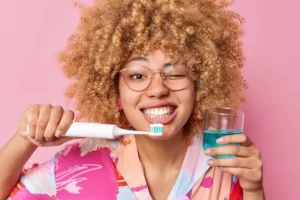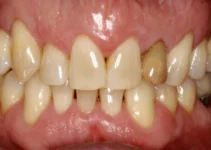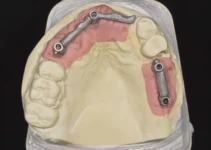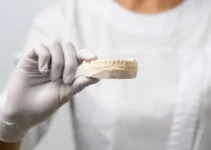Brushing your teeth is a fundamental aspect of maintaining good oral hygiene, but doing it correctly is key to preventing dental problems. Start with the right toothbrush, preferably one with soft bristles and a comfortable grip. Apply a pea-sized amount of fluoride toothpaste and position your brush at a 45-degree angle to your gums. Use gentle circular motions to clean all surfaces of each tooth thoroughly, being careful not to scrub too hard to avoid gum damage. Ensure you brush for at least two minutes, twice a day, and don’t forget to clean your tongue to remove bacteria and freshen breath.
Why Proper Tooth Brushing is Important
Proper tooth brushing is a critical aspect of oral health that not only preserves the appearance of your smile but also has significant implications for your overall well-being. Effective brushing practices help remove food particles and plaque, a sticky film of bacteria that forms on your teeth. When plaque is not regularly removed, it can lead to various dental problems, some of which are irreversible. Understanding the importance of proper tooth brushing can help you commit to a routine that keeps your teeth and gums healthy for years to come.
Emphasizing the importance of proper tooth brushing is supported by numerous studies that have shown a clear link between oral hygiene and systemic health. For instance, poor oral health has been associated with cardiovascular diseases, diabetes, and even complications during pregnancy. As such, maintaining good brushing habits is not just about keeping your teeth white; it’s about safeguarding your entire body’s health.
In addition to reducing the risk of severe health issues, proper tooth brushing contributes to the daily comfort and functionality of your mouth. Regular brushing helps prevent painful conditions such as cavities and gum disease, ensuring that you can enjoy your favorite foods and speak clearly without discomfort. A comprehensive oral hygiene routine is an investment in your long-term health and quality of life.
Preventing Cavities
Cavities, or dental caries, are caused by the breakdown of tooth enamel due to acids produced by bacteria in the mouth. When you brush your teeth effectively, you remove not only food particles but also the bacteria that feed on sugars and produce these harmful acids. This is why using a fluoride toothpaste is essential; fluoride strengthens the enamel, making it more resistant to acid attacks.
According to the American Dental Association (ADA), brushing your teeth twice a day with fluoride toothpaste can significantly reduce the incidence of cavities. Additionally, brushing should be supplemented with flossing to remove plaque from areas where the toothbrush cannot reach, such as between the teeth and under the gumline. Ignoring these areas can leave them vulnerable to decay.
For children, the importance of preventing cavities is even more pronounced. Early childhood caries can affect the development of permanent teeth and lead to long-term dental issues. Teaching proper brushing techniques to children and ensuring they adhere to them can set the foundation for a lifetime of good oral health.
Avoiding Gum Disease
Gum disease, or periodontal disease, is an inflammatory condition affecting the tissues that surround and support your teeth. The early stage of gum disease is known as gingivitis, which is characterized by red, swollen gums that may bleed easily. If left untreated, gingivitis can progress to periodontitis, a more severe form that can lead to tooth loss. Proper tooth brushing plays a crucial role in preventing gum disease by removing plaque that accumulates along the gumline. Plaque buildup is the primary cause of gingivitis. Without removal, the plaque can harden into tartar, which can only be removed by a dental professional and can exacerbate gum inflammation.
Studies have indicated that individuals who maintain good oral hygiene, including regular tooth brushing and professional cleanings, are less likely to develop periodontal disease. In addition to brushing, using an antimicrobial mouthwash can help reduce oral bacteria and further protect your gums.
Gum disease has been linked to other health issues such as heart disease, stroke, and diabetes. Therefore, avoiding gum disease through proper brushing not only preserves your smile but also supports your overall health.
Maintaining Fresh Breath
Halitosis, commonly known as bad breath, can be a source of embarrassment and social discomfort. One of the most effective ways to prevent halitosis is by maintaining good oral hygiene habits, particularly through proper tooth brushing. Food particles and bacteria that are not removed can produce sulfur compounds, which are often the cause of unpleasant odors.
Brushing your tongue as part of your oral hygiene routine is equally important. The surface of the tongue can harbor bacteria and food particles, contributing to bad breath. Using a toothbrush or tongue scraper can help clean this area effectively.
In addition to regular brushing, staying hydrated and avoiding foods that contribute to bad breath, such as garlic and onions, can help maintain fresh breath. Chewing sugar-free gum can also stimulate saliva production, which naturally helps cleanse the mouth and reduce odor-causing bacteria.
Consistent and thorough brushing, combined with these additional steps, ensures that your breath stays fresh, promoting confidence in social and professional interactions.
To truly harness the benefits of proper tooth brushing, explore other articles on comprehensive oral care to further enhance your dental hygiene routine. Learning more about flossing techniques, the use of mouthwash, and regular dental check-ups can complement your brushing efforts and lead to optimal oral health.
Steps to Brush Your Teeth Properly
Brushing your teeth properly is fundamental for maintaining optimal oral health. While it may seem straightforward, many people do not follow the recommended guidelines, leading to issues such as plaque buildup, cavities, and gum disease. Following the correct steps can help ensure that you are getting the most out of your brushing routine. Here are some essential steps to keep in mind.
Proper dental hygiene begins with the right tools and techniques. This includes not just the brush itself but also how you use it and the amount of toothpaste you apply. By understanding these elements, you can maximize the effectiveness of your daily brushing routine and keep your teeth and gums healthy.
Selecting the Right Toothbrush
Choosing the appropriate toothbrush can make a significant difference in how effectively you clean your teeth. A soft-bristled brush is generally recommended by dentists because it is gentle on the gums and enamel yet effective at removing plaque. Harder bristles can cause wear on the teeth and irritate the gums.
Consider the size of the toothbrush head as well. A smaller head allows for better access to all areas of your mouth, including hard-to-reach spots like the back molars. Electric toothbrushes are a good option for many people as they often come with built-in timers and pressure sensors to ensure you are brushing correctly.
When selecting a toothbrush, also pay attention to ergonomics. A comfortable handle with a good grip can make brushing easier and more efficient. Replace your toothbrush every three to four months, or sooner if the bristles are frayed.
Using the Correct Brushing Technique
Using the correct technique is as important as selecting the right toothbrush. Hold your toothbrush at a 45-degree angle to your gums. This position allows the bristles to reach both the teeth and the gumline, where plaque tends to accumulate.
Brush in gentle, circular motions rather than aggressive back-and-forth strokes. This method is more effective in removing plaque without causing damage to your teeth and gums.
Make sure to clean all surfaces of your teeth. This includes the outer, inner, and chewing surfaces. Pay special attention to the inner surfaces of your front teeth by tilting the brush vertically and using up-and-down strokes.
Sufficient time is also crucial. Spend at least two minutes brushing your teeth, and consider dividing your mouth into quadrants to ensure that each section gets the attention it needs.
How Much Toothpaste to Use
The amount of toothpaste you use can impact the effectiveness of your brushing. For adults, a pea-sized amount of fluoride toothpaste is sufficient. Using too much toothpaste can lead to excessive foam, making it difficult to see where you are brushing and potentially leading to spots being missed.
For children, the amount of toothpaste should be even smaller—about the size of a grain of rice for those under three years old, and a pea-sized amount for children aged three to six. This helps reduce the risk of swallowing too much fluoride, which can be harmful.
Fluoride toothpaste is recommended because it helps to strengthen tooth enamel and prevent cavities. However, it is essential to teach children to spit out the toothpaste after brushing to avoid ingesting it.
By following these steps and understanding the key aspects of proper brushing, you can maintain excellent oral hygiene. For more in-depth tips and advanced techniques, be sure to read our other articles on dental care.
Common Mistakes to Avoid
Brushing Too Hard
One of the most common mistakes people make in their oral hygiene routine is brushing too hard. While it might seem logical to assume that more forceful brushing would remove more plaque and debris, it can actually do more harm than good. Aggressive brushing can wear down the enamel on your teeth, making them more susceptible to cavities and sensitivity. It can also cause your gums to recede, which exposes the roots of your teeth and increases the risk of gum disease.
To avoid this, use a soft-bristled toothbrush and apply gentle pressure. It’s the motion and consistency of brushing that remove plaque effectively, not the force. The American Dental Association (ADA) recommends holding the toothbrush at a 45-degree angle to your gums and using short, gentle strokes.
Neglecting the Gum Line
Another critical mistake people often make is neglecting the gum line when they brush. The area where your teeth meet your gums is a prime location for plaque buildup, which can lead to gum disease if not adequately cleaned. Many people tend to focus solely on the surfaces of their teeth, forgetting that their gums need attention too.
To properly clean your gum line, position your toothbrush at a 45-degree angle to your gums. This angle allows the bristles to reach slightly under the gum line, removing plaque and debris that can cause inflammation and infection. Make sure to use gentle, circular motions to avoid harming the delicate gum tissue.
Additionally, incorporating flossing and interdental brushes into your daily routine can help clean areas that a toothbrush might miss. These tools are particularly effective in removing food particles and plaque from between teeth and below the gum line.
Additional Tips for Optimal Dental Health
Maintaining optimal dental health is more than just brushing your teeth twice a day. While this is an essential part of oral hygiene, incorporating other practices can significantly enhance the overall health of your teeth and gums. This section provides additional tips to help you achieve and maintain a healthy smile.
Following these tips not only helps in preventing various dental issues but also ensures your oral cavity remains in the best possible condition. By integrating these practices into your daily routine, you can enjoy a lifetime of strong and healthy teeth.
Using Mouthwash
Incorporating mouthwash into your dental care routine can provide several benefits. Mouthwash helps in reaching areas of the mouth that a toothbrush or floss might miss. It aids in reducing the risk of *gingivitis*, *halitosis*, and *plaque buildup*. Choose a mouthwash that contains fluoride and antibacterial agents to enhance its efficacy.
According to studies, using mouthwash with fluoride can reduce tooth decay by up to 25%. It’s important to use mouthwash correctly to avoid any adverse effects. Swishing the liquid for about 30 seconds post-brushing helps in ensuring that the *active ingredients* are in contact with all tooth surfaces.
Flossing Regularly
Flossing is often neglected, but it plays a crucial role in maintaining dental health. Flossing once a day helps to remove *plaque* and food particles stuck between the teeth and along the gum line, areas that a toothbrush can’t reach. This prevents bacteria from multiplying and causing issues such as *cavities* and *gum disease*.
Several studies have shown that flossing reduces the risk of *periodontitis* significantly. Proper flossing involves using a sufficient length of floss and gently sliding it between the teeth without snapping. Curving the floss around each tooth and ensuring it reaches below the gumline is essential for maximum effectiveness.
Scheduling Regular Dental Checkups
Regular dental checkups are essential in detecting problems before they become serious. Visiting your dentist every six months allows for professional cleaning and early detection of issues such as *cavities*, *gum disease*, or *oral cancer*. These visits also offer an opportunity for professional advice tailored to your specific needs. During these visits, your dentist can provide thorough cleaning, removing *tartar* that regular brushing and flossing can’t eliminate. Additionally, X-rays and other diagnostic tools can detect problems that are not visible to the naked eye. Early intervention can save you from more extensive and costly treatments down the road.
By implementing these additional tips along with your regular brushing routine, you can significantly improve your dental health. For more in-depth information on maintaining optimal oral hygiene, feel free to explore our other articles.
Effective Techniques for Brushing Your Teeth
Brushing your teeth correctly is essential for maintaining oral hygiene and preventing dental diseases. Here’s a comprehensive guide on how to do it properly.
What is the best way to brush your teeth to ensure optimal dental health?
The best way to brush your teeth involves using a soft-bristled toothbrush and fluoride toothpaste. Begin by placing the brush at a 45-degree angle to the gums, gently moving the brush in a circular motion. Brush the outer surfaces, the inner surfaces, and the chewing surfaces of each tooth. Use vertical strokes to clean the inner surfaces of the front teeth. It’s important to brush for at least two minutes, twice a day, and not to press too hard to avoid damaging the gums.

My name is Salman Kapa, a 73-year-old expert in bone regeneration and dental implantology. With decades of experience in the field, I am dedicated to advancing our understanding of oral health and hygiene. Through my research and writing, I aim to contribute to the development of innovative solutions in dental care.




